 Feeding Horses During Natural Disasters: A horse thrives on routine, and nowhere is this more true than in feed management. After the ideal type and amount of grass, hay, and grain are determined for each individual horse, with attention to that animal’s age, body condition, use, and metabolism, it’s best to stick to that regimen to maintain health and avoid digestive upsets. Clean water should always be available. Suppose, however, that unexpected events— floods, fire, winter storms—play havoc with horse management. As horse owners put together a disaster plan and cope with difficult situations, one of the first concerns should be minimizing changes in feed management.
Feeding Horses During Natural Disasters: A horse thrives on routine, and nowhere is this more true than in feed management. After the ideal type and amount of grass, hay, and grain are determined for each individual horse, with attention to that animal’s age, body condition, use, and metabolism, it’s best to stick to that regimen to maintain health and avoid digestive upsets. Clean water should always be available. Suppose, however, that unexpected events— floods, fire, winter storms—play havoc with horse management. As horse owners put together a disaster plan and cope with difficult situations, one of the first concerns should be minimizing changes in feed management.
Water, Water Everywhere
When hurricanes battered the Gulf Coast of the United States in late August of 2005, KER Team Member Quality Feeds in Covington, Louisiana was right in the center of the disaster. From its location directly north of New Orleans, Quality Feeds was ideally situated to provide feed to horse owners whose supplies of hay and grain had been ruined or washed away. But there was a problem: electric power had been disrupted over a wide area. The mill was unable to run for several weeks.
Even though horse lovers across the country quickly rallied to collect and ship truckloads of supplies to the stricken states, feed for large animals was soon in desperately short supply. With roads blocked by flood waters, distribution to horse rescue centers was also difficult. Cory Strander, owner of Quality Feeds, wanted to continue producing feed, but with his mill out of operation, he needed help. Contacting other feed mills that were still up and running—some almost 200 miles away in Texas—Strander arranged to send his feed formulas so his products could be manufactured and distributed.
One of Strander’s biggest clients was the Fair Grounds Race Course in New Orleans. With the barns and track under water, the horses were dispersed to other locations. “It was the off-season,” Strander said. “We have winter racing, and the hurricanes came in the summer. Many of the horses that had been training on our products had to switch to other feeds when they moved.”
The mill owner said he had not heard of many serious health problems or training setbacks from the stress of moving and changing feeds, although such abrupt modifications in management can normally be expected to increase the risk of colic.
With a racing history going back to 1852, the Fair Grounds property has seen devastating floods before. Rebuilding the track in 2005 began when the waters receded, and full recovery is an ongoing process. Racing resumed on Thanksgiving Day of 2006, attracting a record crowd.
If your property is in a flood-prone area:
- Do some planning. Have an evacuation route mapped out; store feed, chemicals, and pesticides where water can’t reach them; build mounds in pastures so livestock can get up out of deep water.
- During a flood, get animals out of barns before they can be trapped by rising water. Provide horses with plenty of hay and clean drinking water.
- A few days of walking in shallow water can usually be tolerated by most large animals. After the water goes down, watch horses for disease signs. For example, fever, lameness, difficulty breathing, muscle twitching, swelling or edema, feed refusal.
- Inspect stored feed and hay for dampness or contamination by chemicals and pesticides.
- Check fields and fence rows for debris, and remove dangerous material before turning out horses. Use fly spray to control insects that tend to proliferate after flooding.
- Avoid driving vehicles and machinery on wet fields. Pastures and hayfields (alfalfa, fescue, and orchard grass) can survive several days of fresh-water flooding. Silt can be left on fields if it isn’t more than a few inches deep. Weed control may be needed in stressed fields. Contact the local agricultural extension service for advice about soil tests and fertilizing.
Fire Alarm!
Romy Ackerberg, horse breeder and owner of Indigo Acres in Montrose, Minnesota, knows firsthand how devastating a fire can be. In July of 2007, an arsonist set fire to the barn where she housed broodmares, foals, and two stallions. Most horses, including her champion American Saddlebred stallion Trust Fund, were saved; some others were lost. Commenting to Ron Genrick of Assurance Feeds, a KER Team Member supplying feed products to her farm, Ackerberg said, “We had rehearsed a plan in case of fire. When it happens, all that goes, and you fly by the seat of your pants.” Neighbors, friends, and strangers heard about the blaze and responded with help of all kinds.
Trucks and trailers soon lined the driveway, and within two hours, more than 50 horses had been relocated. Some went to veterinary clinics for a few days, and others were dispersed to nearby farms. To minimize stress, Ackerberg sent along feed and hay to which the horses were accustomed. “All the horses got along very well,” she reported. “They were in optimum condition due to our nutrition program, and I believe that helped them come through the experience with minimal problems.” A new state-of-the-art facility is now open, and hay is stored in an adjacent shed to reduce the risk of a devastating fire.
Marie Kukawski experienced Australia’s grass and brush fires in February of 2009.
“Many of the fire areas were in very dense scrub and rough terrain, so they were impossible to fight from the ground,” Kukawski said. With strong swirling winds sending flames toward farms and towns at almost 50 miles an hour, there was no guarantee of moving horses to a safe place. She continued, “We had a grass fire that burnt out our back fence. We are very fortunate not to be surrounded by trees. To have enough room to get all 23 horses indoors and protect them as required. We currently have five refugee horses at our place, with another three probably coming in tomorrow as new areas in the hills close to us will be under threat in the next few days.” Though her horses were spared, she reported that a close friend’s horse had to be euthanized because of smoke inhalation.
Barn fire considerations:
- Do some planning. Write out a fire plan. Post it. Practice it.
- Save human life first; then animals; then buildings and property.
- No barn is fireproof. Electric wires, hay, bedding, tack, and furniture in offices can all be involved in a blaze. Install fire extinguishers, practice using them, and have them serviced regularly.
- Horses removed from a burning barn should be enclosed in a paddock or field upwind of the fire to keep them from re-entering the burning building.
- Horses may be impacted by smoke inhalation. Have a veterinarian examine horses after a fire.
Ice, Ice Baby
In late January of 2009, horse owners in Kentucky had to deal with the effects of a sleet storm that left most of the state encased in two inches of ice. The slippery coating turned roads and pastures into skating rinks. Tree limbs and fences sagged, and then crashed to the ground. In some areas of the state, electric service was out for well over a week as wires and utility poles snapped under the shiny coating.
Eileen Phethean and Theresa Lawrence, nutrition advisors for Kentucky Equine Research, were among those responsible for managing horse care in the midst of the storm. Lawrence and her husband, KER nutritionist Larry Lawrence, have a field full of pleasure horses, while Phethean helps to care for Thoroughbred yearlings on a commercial breeding farm. Simply meeting basic needs—feed, hay, water, and shelter—were incredibly difficult and called for a full measure of ingenuity.
“Our six horses are of different breeds, ages, and sizes,” Lawrence explained. “We have some Thoroughbreds, a Thoroughbred/Draft cross, a POA, and a Quarter Horse/Arab cross. Size-wise, they go from 15 to 17.2 hands, and they are from 4 to 27 years of age. The oldest horse is usually stalled a lot during the winter. However, we turned him out because there was no power in the barn and we couldn’t keep his water thawed. To provide a water supply, we had to bring all the horses into the field closest to the house, which was on a different line and did have power, and run extension cords from inside for the tank heaters. We had an outdoor extension cord we could have used to reach tank heaters in other fields, but it was buried in the ice!”
Offset the Weather
To stoke heat-producing hindgut fermentation for her horses, Lawrence increased their hay supply and also boosted the proportion of alfalfa hay in their diets. “We used my daughter’s saucer sled, piled two bales of hay at a time on it, and scooted it across the ice,” she said. “Walking was almost impossible, even on the grass.” Thankfully, none of the horses showed any adverse effects from the storm.
Phethean’s equine charges also weathered the storm well. Management changes included stalling young horses for several days, increasing the hay supply to offset the cold weather, and picking out hooves more frequently to keep snow from building up when the horses were turned out.
“We had electric waterers in the fields, and of course they didn’t work when the power went out,” Phethean said. “We went to get the hose to fill water troughs. However, we found it was under the ice. So we carried a lot of buckets by hand. Then we had to go out frequently to break the ice.” Fortunately the farm had plenty of feed and hay stockpiled ahead of time, but Phethean said some other supplies were lacking.
“There are things you don’t think of,” she said. “It’s a good idea to have plenty of cash, because when you can finally get into town, credit cards may not work at the grocery and feed store if your bank is still without power.”
A chain saw, plenty of gasoline, and an experienced operator were also handy. When some of the ice melted, she drove to check horses in another barn. By the time she made the return trip, a huge tree had fallen and was blocking the road. “I was glad to see a car coming the other way,” she said. “That driver used my chain saw to cut enough of the tree away so that we could get through.”
If your property is in danger of winter storms:
- Do some planning. Keep enough hay and grain on hand to feed for several days without restocking.
- Spread sand on frozen ground to help with footing for horses and humans.
- Provide plenty of hay and fresh water. Extra hay is more important than increased concentrates in maintaining body heat.
- Watch for shivering, and provide shelter or a windbreak (hay bales stacked outside a fence can cut wind chill significantly). Be sure to provide adequate ventilation. Barns should not be airtight.
- Give animals extra bedding in stalls and run-in sheds. Spreading hay outside will help to insulate animals that lie down on snow or ice.
- Check fences, dangling tree limbs, and downed power lines during and after the storm before turning out horses.
Think, Plan, Be Ready
No one wants to dwell on problems that might occur. Nevertheless, adverse conditions can impact horse operations, stressing equines and humans alike. Having a plan can help. Maximizing continuity in feed management can go a long way toward limiting problems in the wake of disaster.
J & J Hay can help to answer horse-health and hay related questions.
Source: Kentucky Equine Research
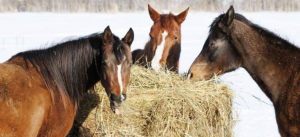 With winter approaching, horse owners will be looking for a source of hay to feed during the season when pasture forage is dormant. Keep these things in mind as you shop for winter hay:
With winter approaching, horse owners will be looking for a source of hay to feed during the season when pasture forage is dormant. Keep these things in mind as you shop for winter hay:
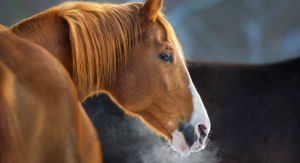 Winter seems so far away, but it is just around the corner. Are you ready? Is your horse ready? Learn how to feed horses in the winter in this post.
Winter seems so far away, but it is just around the corner. Are you ready? Is your horse ready? Learn how to feed horses in the winter in this post.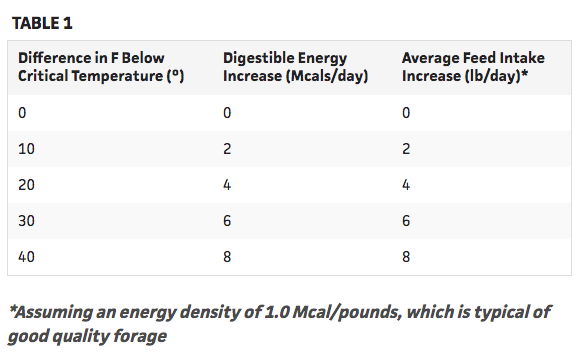
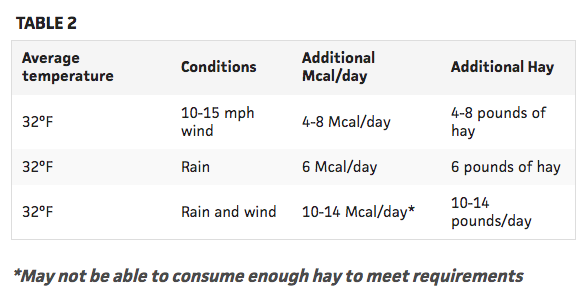
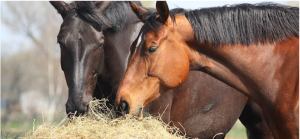 Give Colic the Cold Shoulder This Winter: Colic can strike at any time of the day, month, or year. However, impaction colic occurs more frequently in winter. Decreased water intake usually carries the blame for these impactions. Impactions are a blockage in the large colon. Any feedstuff undergoing digestion causes it. Other management factors also contribute to the problem.
Give Colic the Cold Shoulder This Winter: Colic can strike at any time of the day, month, or year. However, impaction colic occurs more frequently in winter. Decreased water intake usually carries the blame for these impactions. Impactions are a blockage in the large colon. Any feedstuff undergoing digestion causes it. Other management factors also contribute to the problem.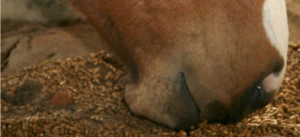 Strategies for Increasing Appetite and Tempting Picky Eaters: Many factors and situations may reduce a horse’s appetite. It’s important to find and correct whatever it is—illness, pain, discomfort, environment—that keeps a horse from diving eagerly into his feed. As the situation is being corrected, owners can try some of the following strategies to encourage a more healthy appetite.
Strategies for Increasing Appetite and Tempting Picky Eaters: Many factors and situations may reduce a horse’s appetite. It’s important to find and correct whatever it is—illness, pain, discomfort, environment—that keeps a horse from diving eagerly into his feed. As the situation is being corrected, owners can try some of the following strategies to encourage a more healthy appetite.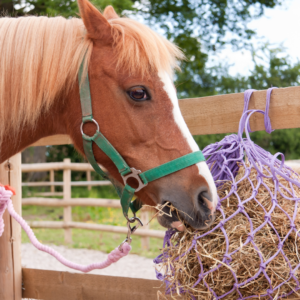 Advantages of Haynets and Hay Feeders for Horses: While forage is the most important part of a horse’s diet, circumstances arise when intake should be limited. Obese horses and ponies with metabolic conditions, for example, may need to have calorie intake controlled carefully to avoid overconsumption of energy. Limiting forage intake can mean less time spent chewing, and with this comes a reduction in saliva production and stomach-acid buffering, all of which sets the stage for gastric ulcers and possible colic.
Advantages of Haynets and Hay Feeders for Horses: While forage is the most important part of a horse’s diet, circumstances arise when intake should be limited. Obese horses and ponies with metabolic conditions, for example, may need to have calorie intake controlled carefully to avoid overconsumption of energy. Limiting forage intake can mean less time spent chewing, and with this comes a reduction in saliva production and stomach-acid buffering, all of which sets the stage for gastric ulcers and possible colic.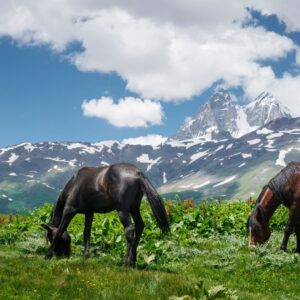 Feeding and Caring for Horses During Cold Weather: Healthy horses usually get along fine in moderately cold weather. A little more care may be necessary for very young or very old equines. In addition, those that are ill or have any sort of chronic health challenge. In extremely cold, wet, or windy weather, almost all horses will benefit from a few adjustments to management.
Feeding and Caring for Horses During Cold Weather: Healthy horses usually get along fine in moderately cold weather. A little more care may be necessary for very young or very old equines. In addition, those that are ill or have any sort of chronic health challenge. In extremely cold, wet, or windy weather, almost all horses will benefit from a few adjustments to management.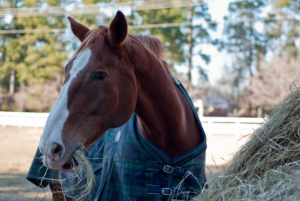 As the warm summer months draw to a close, horse owners stock up on hay for the winter. The hay man has a variety of hays available, including the yellow or brown, less leafy fall hays. Although they might not be as physically attractive and green as the hay harvested earlier in the summer, there are many benefits to late-season hay for horses.
As the warm summer months draw to a close, horse owners stock up on hay for the winter. The hay man has a variety of hays available, including the yellow or brown, less leafy fall hays. Although they might not be as physically attractive and green as the hay harvested earlier in the summer, there are many benefits to late-season hay for horses.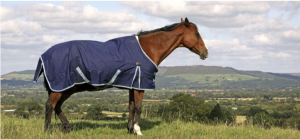 Fall Maintenance for Healthy Winter Horses:
Fall Maintenance for Healthy Winter Horses: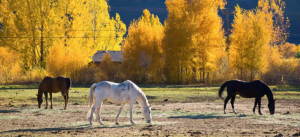 Your Horse: Avoid Being Felled by Fall Founder: If you’ve been involved with horses for any length of time, you’re no stranger to the anguish caused by laminitis. You may be aware of common causes of founder. For example: grain overload, endocrine disturbances, and overloading of supporting limbs, there’s one you may overlook: fall grazing.
Your Horse: Avoid Being Felled by Fall Founder: If you’ve been involved with horses for any length of time, you’re no stranger to the anguish caused by laminitis. You may be aware of common causes of founder. For example: grain overload, endocrine disturbances, and overloading of supporting limbs, there’s one you may overlook: fall grazing. Feeding Horses During Natural Disasters: A horse thrives on routine, and nowhere is this more true than in feed management. After the ideal type and amount of grass, hay, and grain are determined for each individual horse, with attention to that animal’s age, body condition, use, and metabolism, it’s best to stick to that regimen to maintain health and avoid digestive upsets. Clean water should always be available. Suppose, however, that unexpected events— floods, fire, winter storms—play havoc with horse management. As horse owners put together a disaster plan and cope with difficult situations, one of the first concerns should be minimizing changes in feed management.
Feeding Horses During Natural Disasters: A horse thrives on routine, and nowhere is this more true than in feed management. After the ideal type and amount of grass, hay, and grain are determined for each individual horse, with attention to that animal’s age, body condition, use, and metabolism, it’s best to stick to that regimen to maintain health and avoid digestive upsets. Clean water should always be available. Suppose, however, that unexpected events— floods, fire, winter storms—play havoc with horse management. As horse owners put together a disaster plan and cope with difficult situations, one of the first concerns should be minimizing changes in feed management.